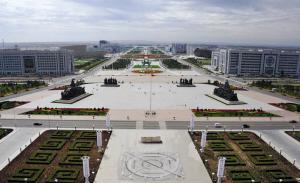(Source: Time Magazine, USA)
No question keeps more economists, investors, hedge-fund managers and bankers up at night than this one: Is China's property market a bubble?
The reason for their angst is clear: A property meltdown in China would imperil the whole world's fledgling economic recovery. Throughout the most severe global downturn in decades, China's economic growth has remained remarkably buoyant. This year, for example, China's GDP will likely rise 9% or more, in contrast to a merely subpar rebound in the U.S. and Europe.
And nothing has driven China's growth more than real estate investment. Last year, fixed-asset investment accounted for more than 90% of China's overall growth, and residential and commercial real estate investment made up nearly a quarter of that.
For years, regional governments across China have been building massive real estate projects that have attracted both private and corporate buyers. As prices have continued to rise (residential values in 70 large and medium-size cities across China soared in 2009, according to real estate consultancy Colliers International), more investors have become speculators, buying brand-new properties with the sole intention of flipping them.
But since a huge real estate bust in the U.S. in 2008 was the catalyst for the still lingering global recession, many analysts fear a replay in China could prove disastrous.
Indeed, evidence of property oversupply is everywhere. In Beijing, vast swaths of commercial space sit vacant — including floors of retail space right next to the iconic Water Cube, the 2008 Olympics swimming venue.
But throughout the Chinese interior, there are even eerier monuments to an as yet unrealized optimism: entire cities built for millions of inhabitants that stand all but empty.
Perhaps the most stark ghost city is Kangbashi, in Inner Mongolia. Built in just five years, Kangbashi was designed to be the showcase urban center of Ordos City, a relatively wealthy coal-mining hub that's home to 1.5 million people. A public-works project worthy of Kubla Khan's "stately pleasure-dome," Kangbashi is filled with office towers, administrative centers, government buildings, museums, theaters and sports fields — not to mention acre on acre of subdivisions overflowing with middle-class duplexes and bungalows. The only problem: the district was originally designed to house, support and entertain 1 million people, yet hardly anyone lives there. Only a handful of cars drive down Kangbashi's multilane highways, a few government offices are open during the day and an occasional pedestrian, appearing like a hallucination, can be seen trudging down a sidewalk, like a lone survivor of some horror-movie apocalypse.
When bubbles burst, they tend to do so with a bang. With the rest of the world still trying to regain its economic footing, authorities in Beijing — and Ordos, for that matter — are hoping they can deflate their housing bubble without a pop. And it's not just the Chinese who should be praying that they can pull it off.
|



